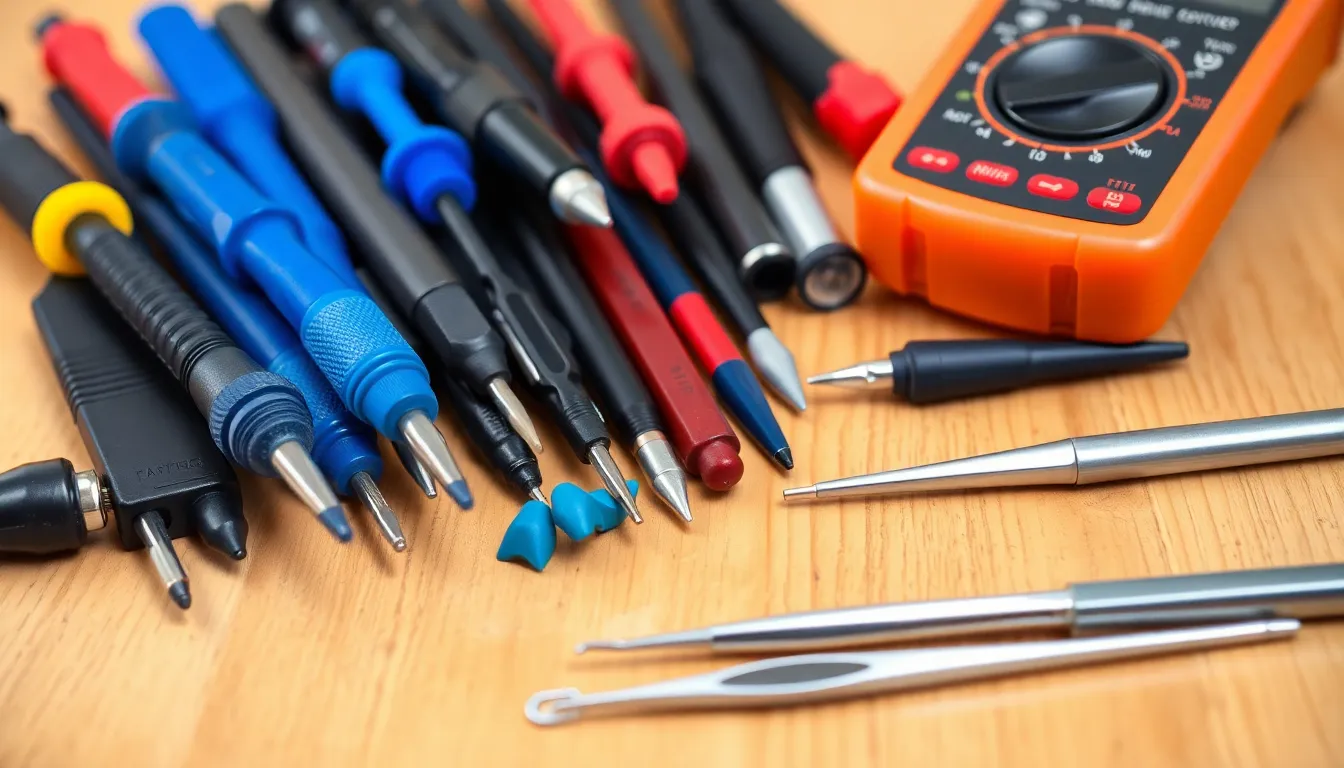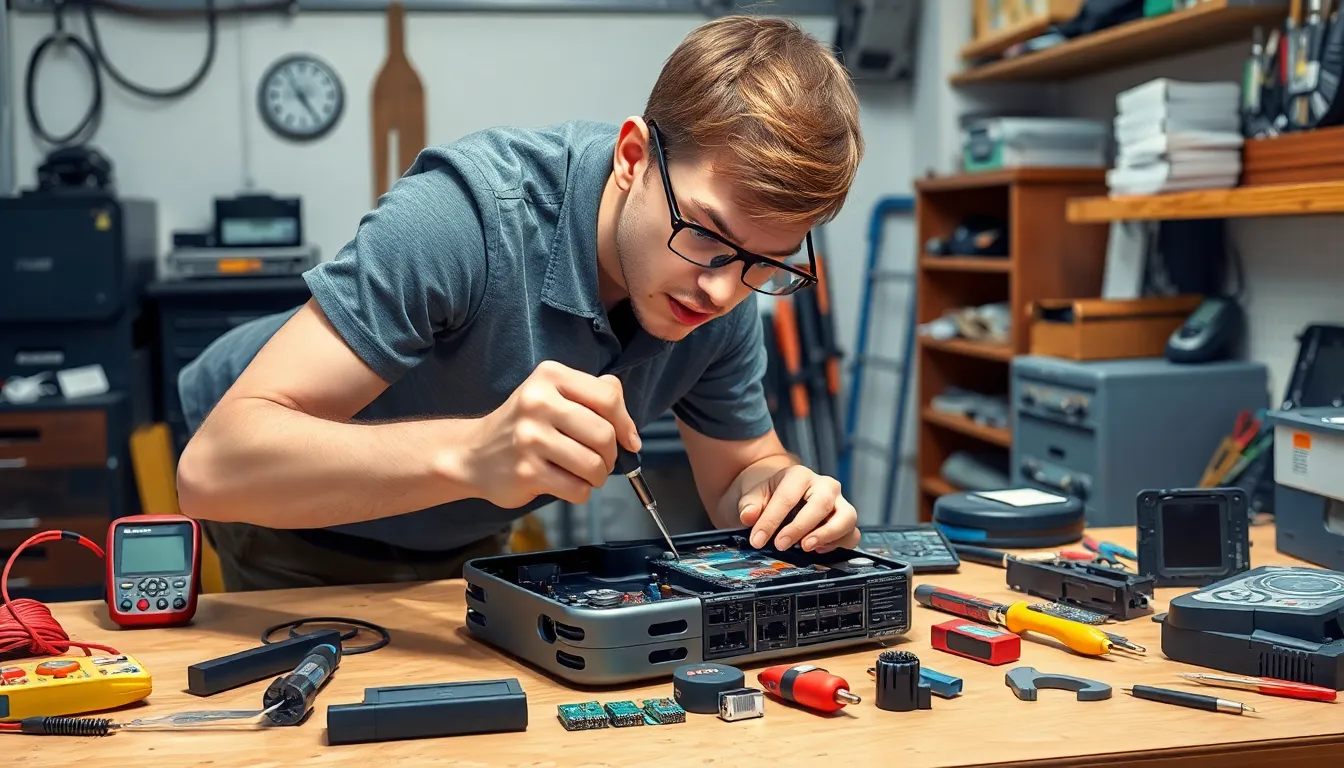Gaming consoles are the lifeblood of many households, providing endless hours of entertainment and a portal to fantastical worlds. But what happens when that beloved console suddenly decides to take an unexpected vacation? Panic sets in, and the quest for gaming console repair begins. Fear not, fellow gamers! With a little know-how and a sprinkle of humor, getting your console back in action can be a breeze.
Gaming Console Repair
Gamers often encounter various issues with their consoles. Understanding these common problems aids in quicker resolutions.
Hardware Failures
Hardware failures frequently disrupt gaming experiences. Power supply malfunctions can prevent consoles from starting. Overheating occurs when consoles are poorly ventilated, causing performance throttling. Controllers may also face battery or connectivity issues, which hinder gameplay. Display problems might arise from loose cables or faulty HDMI ports, impacting visual output. Regular maintenance helps identify potential hardware issues early.
Software Glitches
Software glitches present another layer of frustration for gamers. System updates sometimes fail, leading to incomplete installations that render consoles unresponsive. Game crashes often occur during high-demand sequences, interrupting immersive gameplay. Corrupted files or bugs within games can also cause freezing or unexpected errors. A simple reboot usually addresses minor software hiccups, while clearing cache helps fix persistent issues. Staying informed about updates aids in avoiding many of these software-related problems.
Tools Required for Repair

Repairing a gaming console requires specific tools. Using the right equipment not only simplifies the process but also increases the likelihood of successful repairs.
Essential Tools
Screwdrivers are vital for opening the console casing. A set of precision screwdrivers ensures compatibility with various screw types. Plastic spudgers help in prying open the device safely without causing damage. Tweezers assist in handling small components during repairs. A multimeter is useful for checking voltage and diagnosing power supply issues. Lastly, an anti-static wrist strap protects sensitive electronic parts from static electricity.
Optional Tools
Heat guns can aid in softening adhesive for easier disassembly. Digital cameras or smartphones serve well for documenting assembly steps. Replacement parts, including thermal paste and fans, enhance console longevity. Cleaning solutions for dust and grime help maintain performance. Diagnostic tools can assist in troubleshooting deeper software or hardware issues. These optional tools simplify the repair process further.
Step-by-Step Repair Guide
Repairing a gaming console involves a systematic approach. Following these steps helps diagnose and solve common issues effectively.
Diagnosing the Problem
Identifying the root cause of the malfunction remains critical. Start by observing the console’s behavior, such as unusual noises or error messages. Note any recent changes, like software updates or hardware installations. Checking connections and power supply ensures everything is plugged in properly. If issues persist, running a diagnostic test often reveals hidden problems. Refer to manufacturer resources for specific troubleshooting guides, which can pinpoint concerns more accurately.
Fixing Hardware Issues
Addressing hardware problems often requires careful attention. First, remove the console’s outer casing using precision screwdrivers. Inspect for visible damage, such as burnt components or loose connections. If the power supply proves faulty, replacing it becomes necessary. Overheating issues might necessitate cleaning dust accumulation from vents and fans. Reconnecting controllers can resolve connectivity problems quickly. Each hardware repair should use appropriate tools and replacement parts to ensure reliability.
Resolving Software Problems
Software glitches can disrupt gaming experiences significantly. Begin by checking for available system updates, as these might resolve existing issues. Resetting the console can often restore functionality after software errors occur. In cases of game crashes, deleting and reinstalling problematic titles may solve the issue. If error codes appear, searching them online can lead to specific solutions. Factory resetting the console provides a last-resort option, restoring it to factory settings to eliminate persistent software complications.
When to Seek Professional Help
Recognizing when to pursue professional help for a gaming console is crucial. Signs of severe hardware issues include persistent overheating, failure to power on, or strange noises during operation. If extensive troubleshooting doesn’t resolve symptoms, contacting a technician becomes necessary.
Dealing with software glitches can also prompt professional assistance. Frequent crashes, error messages during system updates, or unresponsive menus might indicate deeper problems. When simple resets or updates don’t resolve these issues, experts can offer solutions.
Professionals can access specific diagnostic tools not available to consumers. These tools facilitate a more thorough examination of the console’s internal systems. Technicians bring expertise that helps identify complex issues faster than typical home repairs.
Another reason to seek help is warranty considerations. Attempting repairs without proper knowledge often voids warranties. If the console remains under warranty, reaching out to the manufacturer ensures coverage remains intact.
Complex repairs also warrant professional attention. Examples include problems with motherboard components or when original parts require replacement. Professional services provide authentic replacement parts that maintain quality and compatibility.
Financial aspects shouldn’t be ignored. Evaluating repair costs versus console replacement can guide the decision. If repair fees surpass the price of a new console, a replacement might be the preferred choice.
Determining the right time for professional assistance can determine lasting console health. Gamers experiencing persistent issues should weigh their options carefully. It’s advisable to prioritize effective solutions to enjoy uninterrupted gaming.
Conclusion
Repairing a gaming console doesn’t have to be a daunting task. With the right tools and knowledge, gamers can tackle common issues and restore their beloved devices. Regular maintenance and staying informed about updates play a crucial role in preventing malfunctions and enhancing overall performance.
When faced with persistent problems or complex repairs, seeking professional help can save time and ensure proper handling. Understanding when to DIY and when to call in experts is key to maintaining a seamless gaming experience. Ultimately, being proactive in repairs and maintenance allows gamers to enjoy their consoles for years to come, ensuring that the entertainment and escapism they provide remain uninterrupted.

